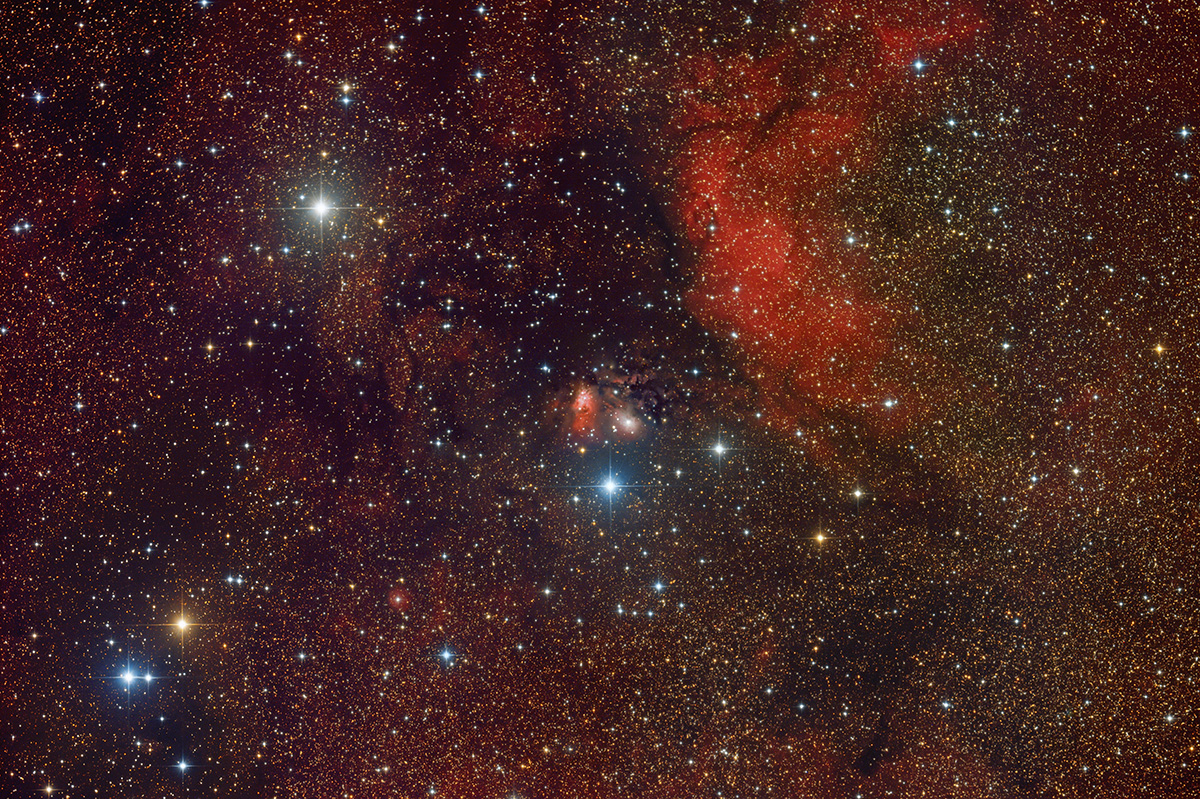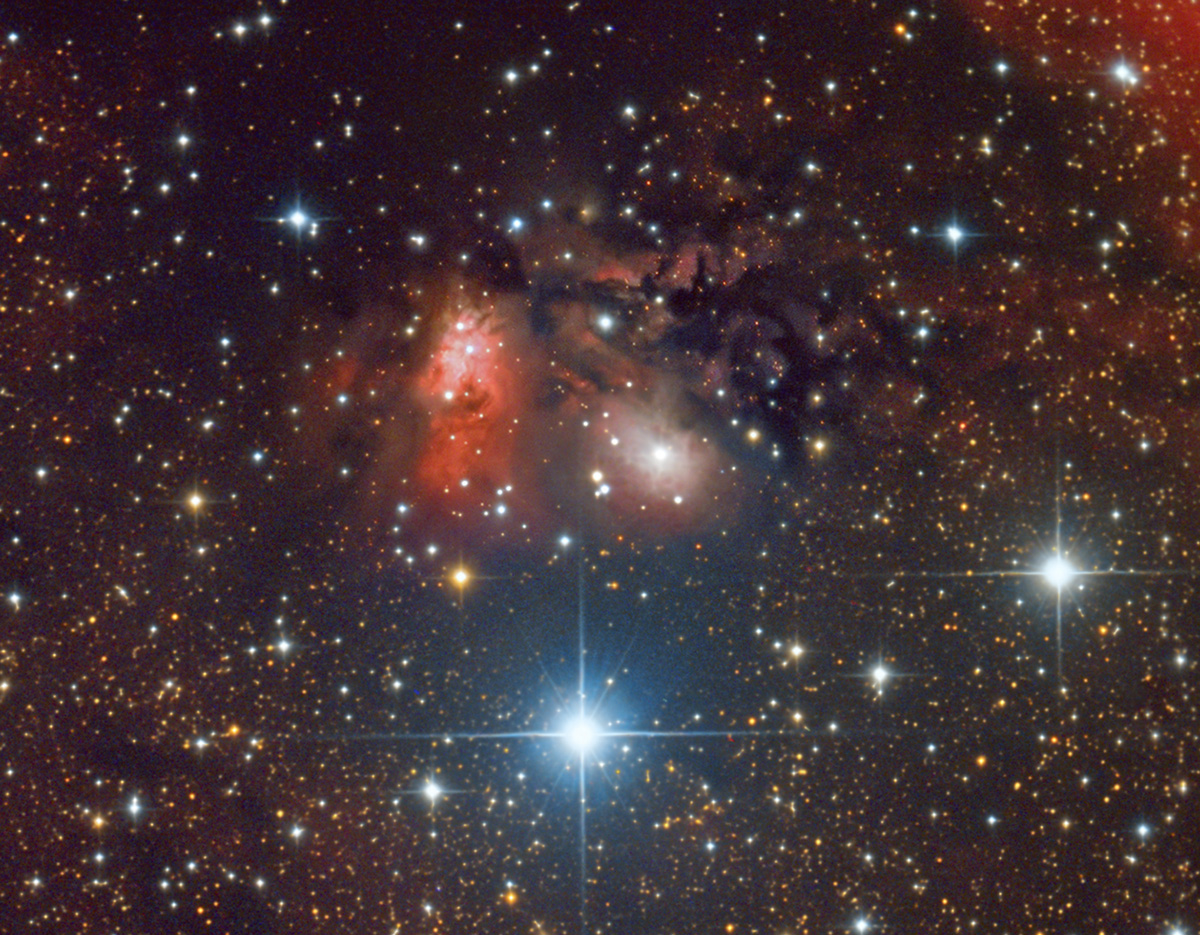
[back] Sh2-88 in Vulpecula [NED]
Higher resolved image / höher aufgelöstes Bild (3540 x 2357 Pixel)

|
(c) 2021 All astro photo images are copyrighted. They may not be used or reproduced without explicit written permission from the authors. |
|
300' |
|
About this Image / Über dieses Bild
| CCD: | ZWO ASI094MC Pro |
| Image Type, Orientation: | RGB-HaOIII-Composite, North is at 12:00 h |
| Exposure time: | R,G,B: 24x300 sec., Ha,OIII: 24x300 sec., all 1x1 bin (4h total) |
| Exposure date: |
July 18th/19th 2021 |
| Location: | Capella Observatory at Eifel, Germany, remote-controlled from Bad Arolsen/Germany |
| Filter: | Internal RGB-Filter and STC Astro Duo-Narrowband Filter |
| Instrument: | Ganymed 60cm-Hypergraph in primary focus (f=1815.9 mm) |
| Photographer: | Josef Pöpsel, Stefan Binnewies, Frank Sackenheim |
| Remarks: |
A 80% crop of the central part of the image can be found below. |
|
Bemerkungen: |
Ein 80%-Crop des zentralen Bereichs der Aufnahme ist unten zu finden |

|
(c) 2021 All astro photo images are copyrighted. They may not be used or reproduced without explicit written permission from the authors. |
|
When stacking the raw data, a green spot was noticed slightly above the center of the image, which, due to its color and shape, could not possibly be a star (see image below left). Should a comet have slipped into the picture ?! The spot could be seen in all raw images (including those made with the HaOIII filter, but clearly weaker there). The riddle was only solved by animating the individual images. In the image below on the right, four of the 28 RGB single exposures can be seen as animation. In addition to the stars dancing around - caused by the dithering of the individual images - a few fixed hot pixels can be seen - and the green dot jumping around. But its movement is a mirror image of that of the stars. And that makes the most likely explanation simple: it is the reflection of a star on the opposite side of the optical axis - presumably SAO 87706, the star directly below the two central nebulae. With a brightness of 6.65mag it is tens of thousands of times brighter than most of the other stars in the picture. It should be bright enough to cause a visible reflection through the coated entrance window of the camera. A little green man who happens to be buzzing around synchronously with the dithering of the camera is rather unlikely. We have therefore "cleaned up" the dot in the resulting images.
Beim Stacken der Rohdaten fiel ein grüner Fleck etwas oberhalb des Bildzentrums auf, der aufgrund von Farbe und Form unmöglich ein Stern sein konnte (siehe Bild unten links). Sollte uns ein Komet ins Bild gehuscht sein?! Der Fleck war in allen Rohbildern zu erkennen (auch denen, die mit dem HaOIII-Filter gemacht wurden, dort aber deutlich schwächer). Erst einen Animation der Einzelbilder brachte des Rätsels Lösung. Im Bild unten rechts sind vier der 28 RGB-Einzelbelichtungen als Animation zu sehen. Außer den umhertanzenden Sternen - hervorgerufen durch das Dithering der Einzelaufnahmen - sind ein paar ortsfeste Hot-Pixel zu erkennen - und der umherspringende grüne Punkt. Seine Bewegung ist aber spiegelbildlich zu denen der Sterne. Und das macht die wahrscheinlichste Erklärung einfach: es handelt sich um den Reflex eines Sternes auf der gegenüberliegenden Seite der optischen Achse - vermutlich SAO 87706, dem Stern direkt unterhalb der beiden zentralen Nebel, der mit einer Helligkeit von 6.65mag zig tausendfach heller ist als die meisten anderen Sterne im Bild. Er sollte hell genug sein, um einen sichtbaren Reflex durch das beschichtete Eintrittsfenster der Kamera hervorzurufen. Ein zufällig synchron mit dem Dithering der Kamera umherschwirrendes kleines grünes Männchen ist eher unwahrscheinlich. Wir haben den Fleck in den Ergebnisbildern deshalb "rausgeputzt".
|
|
|
Back to the Diffuse Nebulae Overview / Zurück zur Diffuse-Nebel-Übersichtsseite